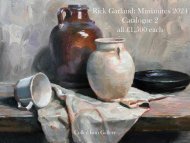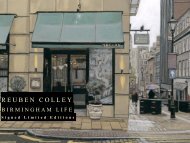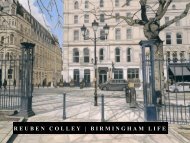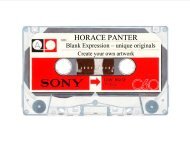You also want an ePaper? Increase the reach of your titles
YUMPU automatically turns print PDFs into web optimized ePapers that Google loves.
<strong>Bridget</strong> <strong>Riley</strong><br />
<strong>Selected</strong> <strong>Works</strong>
<strong>Bridget</strong> <strong>Riley</strong>, (born April 24, 1931, London, England), English artist whose vibrant optical pattern paintings were<br />
central<br />
to the Op art movement of the 1960s.<br />
<strong>Riley</strong> spent her childhood in Cornwall and attended Goldsmiths College (1949–52; now part of the University of<br />
London) and the Royal College of Art (1952–55; B.A.). Until 1960 she painted primarily impressionistic<br />
landscapes and figures. Her study of the Pointillists, particularly Georges Seurat, led her to experiment with<br />
colour juxtaposition and optical effects, and under the influence of Victor Vasarely and others, her work took on<br />
a geometric abstraction, in which intricate patterns of black and white and, later, alternating colours were<br />
calculated to produce illusions of movement and topography. In 1965<br />
she participated with Vasarely, Yaacov Agam, and others in a noteworthy international exhibition entitled “The<br />
Responsive Eye” at the Museum of Modern Art (MoMA) in New York City. She won a first prize for painting at<br />
the Venice Biennale in 1968. Her notable works from this period included Drift No. 2 (1966) and Nineteen<br />
Greys (1968).<br />
<strong>Riley</strong>’s experiments with optical illusions continued throughout her career. In 1967 she introduced colour into<br />
her work, making her first stripe paintings. She sometimes broke from geometric forms in the 1970s to create<br />
what she termed curve paintings, in which waving lines give the impression of undulating movement. Notable<br />
examples include Gala (1974) and Entice 2 (1974). In the 1980s <strong>Riley</strong> introduced diagonal lines, creating a<br />
series she called rhomboid paintings. She also began to adapt her palette to match the pigments she saw on her<br />
travels to such countries as Egypt (Achæan [1981]) and India (Nataraja [1993]). Her work from the 21st century<br />
took on a more lyrical quality, its forms inspired by the arabesque, as in Rajasthan (2012). <strong>Riley</strong> also received a<br />
number of commissions for wall murals, a practice she began with the design for the Royal Liverpool Hospital<br />
in 1983. Such pieces include Bolt of Colour (2017), a temporary work for the Chinati Foundation, Marfa,<br />
Texas, and Messengers (2019), a permanent installation at the National Gallery, London.
<strong>Bridget</strong> <strong>Riley</strong> | Winged Curve |1966<br />
Silkscreen on paper | Signed edition of 75 | 63 x 58 cm<br />
Although printed in 1966, Winged Curve was not published at that time. The work was printed on rectangular sheets and <strong>Riley</strong> felt, then, that the<br />
image had not quite worked.<br />
The edition was kept in the studio. Upon rediscovery and long consideration, around the turn of the century, the decision was taken to crop the<br />
sheet to the near-square format that we see today. This adjustment resolved <strong>Riley</strong>'s concerns and, happily, the edition was signed and released in<br />
2001.<br />
Under £45,000<br />
Please click here to view on website
<strong>Bridget</strong> <strong>Riley</strong> | Fold |2004<br />
Silkscreen in colours, plus white under print on Fabriano 5 paper | Signed edition of 250 | 38 x 45 cm<br />
Under £13,000<br />
Please click here to view on website
<strong>Bridget</strong> <strong>Riley</strong> | Sideways | 2010<br />
Silkscreen on paper | Signed edition of 250 | 33 x 46 cm<br />
Under £13,000<br />
Please click here to view on website
<strong>Bridget</strong> <strong>Riley</strong> in her studio

















